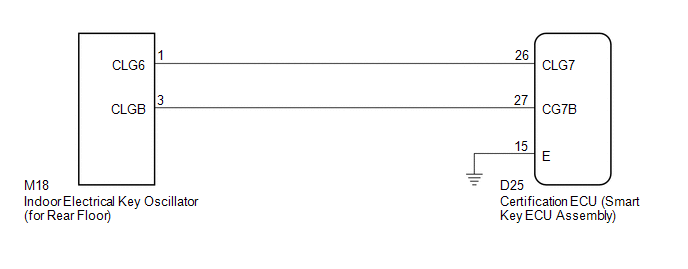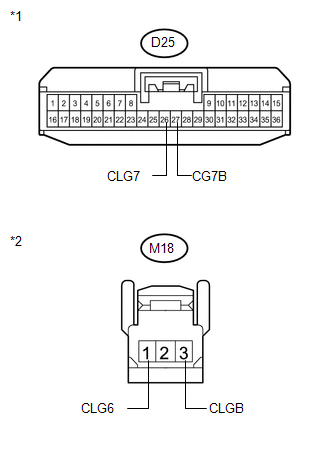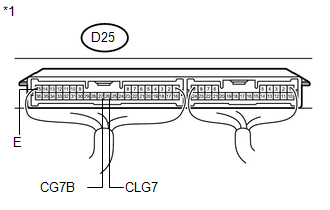Toyota Venza: Open in Inside Luggage Compartment Electrical Key Oscillator Circuit (B27A7)
DESCRIPTION
The certification ECU (smart key ECU assembly) generates a request signal and sends it to the indoor electrical key oscillator (for rear floor). To detect the key inside the cabin, the indoor electrical key oscillator (for rear floor) creates a detection area in the cabin.
DTC B27A7 is detected by the certification ECU (smart key ECU assembly) when an open circuit occurs between the certification ECU (smart key ECU assembly) and indoor electrical key oscillator (for rear floor) terminals (between CLG7 and CLG6, or CG7B and CLGB).
|
DTC No. |
DTC Detection Condition |
Trouble Area |
|---|---|---|
|
B27A7 |
Open circuit detected between the certification ECU (smart key ECU assembly) and indoor electrical key oscillator (for rear floor) terminals (between CLG7 and CLG6, or CG7B and CLGB). |
|
WIRING DIAGRAM

CAUTION / NOTICE / HINT
NOTICE:
The smart key system (for entry function) uses a multiplex communication system
(LIN communication system) and CAN communication system. Inspect the communication
function by following How to Proceed with Troubleshooting (See page
.gif) ). Troubleshoot the smart key system (for entry
). Troubleshoot the smart key system (for entry
function) after confirming that the communication system is functioning properly.
PROCEDURE
|
1. |
CHECK CONNECTOR CONNECTION CONDITION |
(a) Turn the engine switch off.
(b) Check that the connectors are properly connected to the certification ECU (smart key ECU assembly) and the indoor electrical key oscillator (for rear floor).
OK:
Connectors are properly connected.
| NG | .gif) |
CONNECT CONNECTORS PROPERLY |
|
|
2. |
CHECK HARNESS AND CONNECTOR (CERTIFICATION ECU - INDOOR ELECTRICAL KEY OSCILLATOR) |
(a) Disconnect the certification ECU (smart key ECU assembly) connector.
|
(b) Disconnect the indoor electrical key oscillator (for rear floor) connector. |
|
(c) Measure the resistance according to the value(s) in the table below.
Standard Resistance:
|
Tester Connection |
Condition |
Specified Condition |
|---|---|---|
|
D25-26 (CLG7) - M18-1 (CLG6) |
Always |
Below 1 Ω |
|
D25-27 (CG7B) - M18-3 (CLGB) |
Always |
Below 1 Ω |
|
D25-26 (CLG7) - Body ground |
Always |
10 kΩ or higher |
|
D25-27 (CG7B) - Body ground |
Always |
10 kΩ or higher |
|
M18-1 (CLG6) - Body ground |
Always |
10 kΩ or higher |
|
M18-3 (CLGB) - Body ground |
Always |
10 kΩ or higher |
|
*1 |
Front view of wire harness connector (to Certification ECU (Smart Key ECU Assembly)) |
|
*2 |
Front view of wire harness connector (to Indoor Electrical Key Oscillator (for Rear Floor)) |
| NG | .gif) |
REPAIR OR REPLACE HARNESS OR CONNECTOR |
|
|
3. |
INSPECT CERTIFICATION ECU (SMART KEY ECU ASSEMBLY) (INDOOR ELECTRICAL KEY OSCILLATOR SIGNAL OUTPUT) |
|
(a) Reconnect the certification ECU (smart key ECU assembly) connector. |
|
(b) Measure the resistance and check for pulses according to the value(s) in the table below.
Standard Resistance:
|
Tester Connection |
Condition |
Specified Condition |
|---|---|---|
|
D25-15 (E) - Body ground |
Always |
Below 1 Ω |
Standard:
|
Tester Connection |
Condition |
Specified Condition |
|---|---|---|
|
D25-26 (CLG7) - D25-15 (E) |
|
No pulse generation |
|
D25-26 (CLG7) - D25-15 (E) |
|
Pulse generation |
|
D25-27 (CG7B) - D25-15 (E) |
|
No pulse generation |
|
D25-27 (CG7B) - D25-15 (E) |
|
Pulse generation |
|
*1 |
Component with harness connected (Certification ECU (Smart Key ECU Assembly)) |
| NG | .gif) |
REPLACE CERTIFICATION ECU (SMART KEY ECU ASSEMBLY) |
|
|
4. |
REPLACE INDOOR ELECTRICAL KEY OSCILLATOR (for Rear Floor) |
(a) Replace the indoor electrical key oscillator (for rear floor) (See page
.gif) ).
).
|
|
5. |
CHECK DTC OUTPUT |
(a) Clear the DTCs (See page .gif) ).
).
(b) Recheck for DTCs.
OK:
DTC B27A7 is not output.
| OK | .gif) |
END (INDOOR ELECTRICAL KEY OSCILLATOR WAS DEFECTIVE) |
| NG | .gif) |
REPLACE CERTIFICATION ECU (SMART KEY ECU ASSEMBLY) |
 Open in Rear Floor Electrical Key Oscillator Circuit (B27A6)
Open in Rear Floor Electrical Key Oscillator Circuit (B27A6)
DESCRIPTION
The certification ECU (smart key ECU assembly) generates a request signal and
sends it to the indoor electrical key oscillator (for center floor). To detect the
key inside the cabin, ...
 Open in Front Floor Electrical Key Oscillator Circuit (B27A5)
Open in Front Floor Electrical Key Oscillator Circuit (B27A5)
DESCRIPTION
The certification ECU (smart key ECU assembly) generates a request signal and
sends it to the indoor electrical key oscillator (for front floor). To detect the
key inside the cabin, t ...
Other materials about Toyota Venza:
PBD Pulse Sensor Malfunction (B2222)
DESCRIPTION
A pulse sensor is built into the power back door ECU (power back door
motor unit) to detect foreign objects and the back door position. The pulse
sensor monitors the operating speed of the back door to detect foreign objects.
Th ...
Lost Communication with ECM / PCM "A" (U0100,U0129)
DESCRIPTION
The combination meter assembly communicates with the ECM via the CAN communication
system (CAN No. 1 Bus).
DTC No.
DTC Detection Condition
Trouble Area
U0100
When either of the follow ...
Air Outlet Damper Control Servo Motor Circuit (B1443/43)
DESCRIPTION
The air outlet control servo motor sends pulse signals to indicate the damper
position to the A/C amplifier. The A/C amplifier activates the motor (normal or
reverse) based on these signals to move the mode damper to any position, which contro ...
0.1239

.gif)

